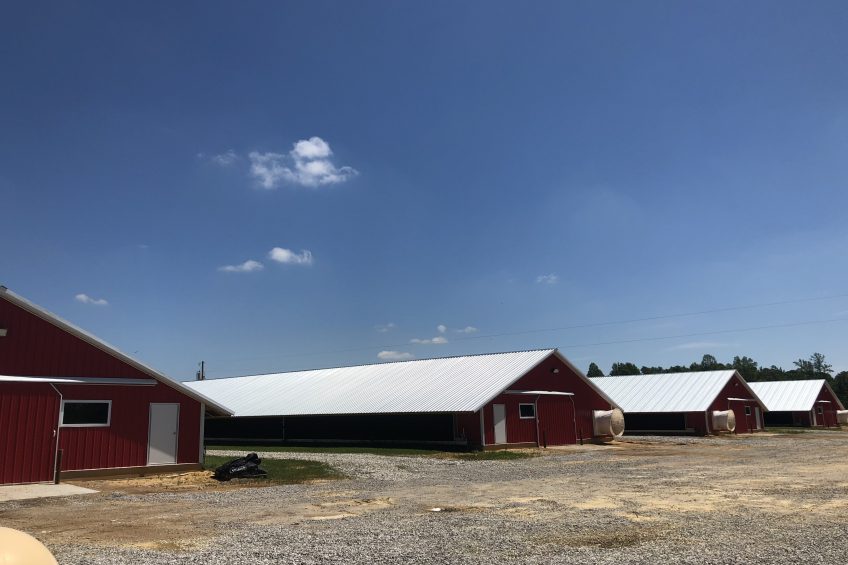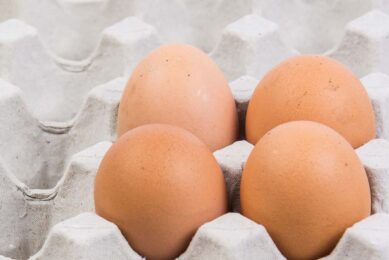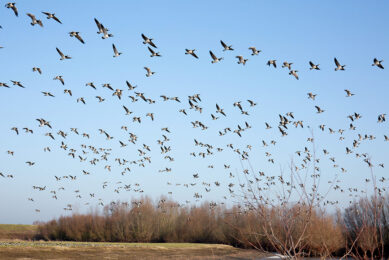Striving to improve poultry farming’s image

Transparency in the poultry industry is a big issue in the United States, with misconceptions among consumers extremely high. One family are doing their best to alter perceptions. Melanie Jenkins travelled to Kentucky to find out more.
It’s common for the public to think that broiler chickens are reared in horrific conditions in the US, but Danielle and Daniel Hayden have made it their mission to lead a change in public opinion for the better.
Running a poultry and beef enterprise in Pilpot, Kentucky, with Mr Hayden’s parents; Joan and Martin, the young couple have installed a viewing room inside one of their poultry houses. As the first of its kind in the US, it’s leading the way for the industry to connect with the public.
New blood
The idea first came about when the couple got married four years ago, and Mrs Hayden moved to the farm. “I knew the beef industry but I didn’t know anything about poultry,” she explains. “I realised that the bad things I had heard about the industry were wrong. I have an agri-communication degree and have been involved with agriculture but everything I had heard about poultry had been negative.
“On seeing it and being involved with it, I realised that it’s not scary, it’s not any of the bad things I’d been told and I felt if others could see this, they’d have no cause to worry.” Though she was blogging at the time, the industry was nervous about her speaking out about the misconceptions, so instead she looked at creating their own glass barn project.
The family produce on behalf of Perdue – the fourth largest poultry producer and processor in the US – with which they have a 15-year contract. Purdue was also integral in the expansion of the business and the setting up of the public viewing room.
Long-term loan
“They wanted to be involved and wanted to pay for the viewing room,” explains Mrs Hayden. The farm already had four 24,000-bird houses but the family decided to expand and put up four new 31,000-bird houses on a new, more appropriate site for visitors. Perdue financed the $ 1.4m (£1.05m) building work of the houses and as part of the family’s contract, this will be paid off over the 15 years, when they will be debt free.
“They pay for us to supply them with broilers for 15 years,” says Mr Hayden. “This is enough to pay back the loan and to live off well – then after the 15 years, our income will triple. It guarantees that after 15 years we will be debt free but you have to put the work in for the income.”
Mrs Hayden adds: “We wanted to get the community involved and give an experience where they could come out to the farm, so we looked to build a space where we could bring people together, but where they could also see chickens.” The beauty of the project is that visitors to the farm will not be going solely to see and learn about the broilers, but for any number of other group activities, including dinners, cooking classes and yoga. The couple went to the Kentucky Department of Agriculture – the state government body for regulating and promoting agriculture – with the idea of creating a community space and its response was extremely positive. “They were super excited and offered us $ 60,000 (£45,400) if we could match fund it,” says Mrs Hayden.

Local interest
Mr Hayden approached a number of local businesses and got a lot of interest. “It’s something that had never been done in the US.” They had a number of organisations donate money, including the Kentucky Corn Growers’ Association, the Kentucky Soybean Association and the Farm Credit of Mid-America. As a result, they have been able to build a hall with a kitchen and toilets for the public to hire out and use.
“What we didn’t want to create was an agri-tourism spot,” says Mr Hayden. “We didn’t want to bring in masses of school kids as the biggest impact group are the adults.” The couple realised that targeting school ages wouldn’t make enough of an impact because these children would always be influenced by the opinions and predispositions of their parents. “Our objective is not to tell people how it is, but to give them an experience and let them make up their own minds.”
Great response
The project is not yet finished but the plan is to have an official launch in July. “We launched a website in November 2017, and the response was so great that the alerts coming through on my phone caused it to crash,” says Mrs Hayden. “We’ve had such a great response that we’ve hosted two group visits a month despite not being officially open yet.” The opening itself is due to host industry and state officials from across the country, as well as senators. “The set up is one of a kind and the first for our poultry industry,” she adds.
Some of the biggest misconceptions the couple are trying to tackle include the idea that broilers are kept in cages, that farmers are allowed to use growth promotors and hormones, and that the chickens are unable to behave like chickens.
Challenges
One of the challenges the family have faced is their insurance policy. “We can only insure for losses that occur from natural disaster,” says Mr Hayden. “We had a hurricane that killed 36,000 birds and we’ve had an ice storm that killed 38,000 birds when the power went out and the back-up generator failed.” However, Purdue has been very good to them and loaned the lost revenue to help them out during difficult periods on top of playing an integral part in setting up and funding the public viewing window. The couple hope to continue their good relationship with Purdue. “We enjoy raising for them and they’ve helped us out as much as they can.”
The Hayden family’s poultry setup The couple receive the broilers at 24-hours old and grow them to 6.5lbs in 46-48 days. “This is all to do with their genetics,” explains Mr Hayden. They produce entirely antibiotic free commercial Ross chickens and raise about 1.2 million birds a year in eight houses, with mortality rates around 3-5%. Four of the houses are 600×43 feet and the other four are 500×43 feet, spread across two sites, with a 15-minute drive between them. The houses all have windows and climate control, with six hours of darkness. Birds are fed and watered via two automatic feed lines and four automatic nipple drinker lines per house, with an alert system set up to contact the family should any anomalies or incidents occur, such as a feed bin running out of feed. The alert system sends messages for minor alerts and will call the family one after another when big issues occur, until someone picks up. Mr Hayden also has his phone set up so that he can control everything in the houses from it. In terms of management, the houses are walked twice a day and visited three to four times a day. The next step will be getting real time weighing of the birds via electronic scales. “We’re essentially just the babysitters as Purdue brings in the feed,” explains Mrs Hayden.” If the firm was able to source organic feed the couple would convert to organic production. However, Purdue pays bonuses for performance and during certain times of the year helps with increased electricity bills in the summer and higher gas bills in the winter. Purdue’s flock supervisors visit the farm weekly and help with any problems or point out any issues, says Mr Hayden. “Because they own the birds, they want to be sure we’re raising them properly.” In the larger houses, the birds are fed 16 tonnes of starter feed per house for the first 13 days, rising to 21.7 tonnes in the last week. Feed conversion rates in the first few days are 98% and average out at 1.77lbs of feed per 1lb of weight gained over a 48-day period. Feed includes distillers’ maize, soya beans, grains and marigold flowers – to help with nutrition and meat colour. Being antibiotic free means the family have certain jurisdictions in place. “If we did have to administer antibiotics, the entire flock would have to be treated and our farm would be separated out to be processed by itself,” explains Mrs Hayden. “Then our birds would be sold under a different label and not marketed as antibiotic free. We have personally never had that happen.” Citric acid and copper sulphate are administered through the drinking water to modulate the birds’ internal pH and manage their gut function. “This keeps them healthy and is all we do when it comes to additives,” explains Mr Hayden. When it comes to bird health, they spray for insect control between each flock, and litter management is key, explains Mr Hayden. “We have five inches of litter on top of bare dirt.” Birds perform better on chicken litter than sawdust due to the beneficial microbial loading. This improves their gut function and they become more resistant to disease. So we manage our litter which helps to control bugs and ammonia, and we only change it every five or six flocks.” Between flocks the litter is raked up into rows and left to compost in the sheds. It hits about 60°C for 78 hours and then is turned over. “This kills off insects and creates an ideal environment for microbial growth that helps with gut function.” The chickens have had no issues with campylobacter and Mr Hayden says the flocks have developed a great immunity. |
Join 31,000+ subscribers
Subscribe to our newsletter to stay updated about all the need-to-know content in the poultry sector, three times a week. Beheer
Beheer








 WP Admin
WP Admin  Bewerk bericht
Bewerk bericht